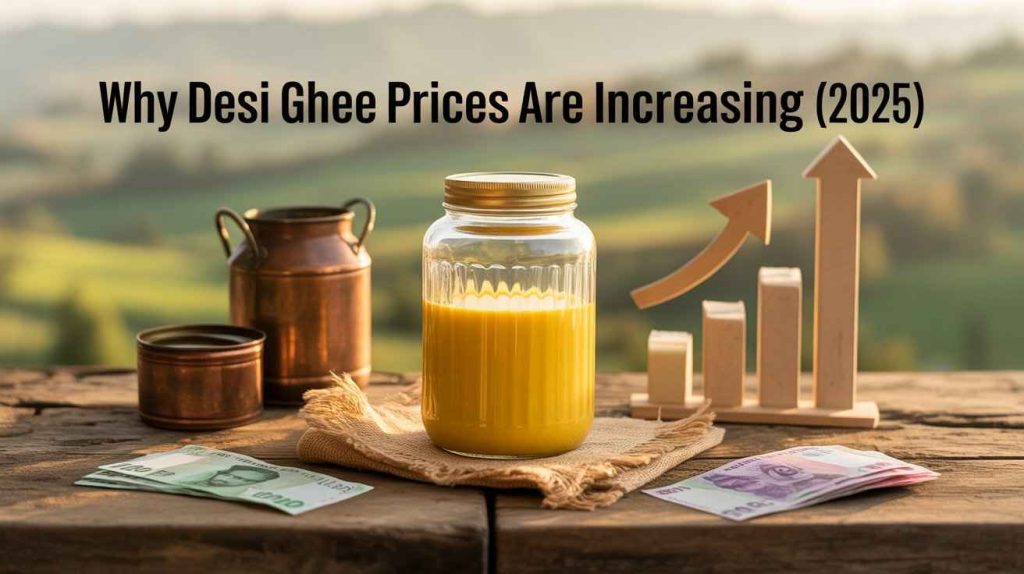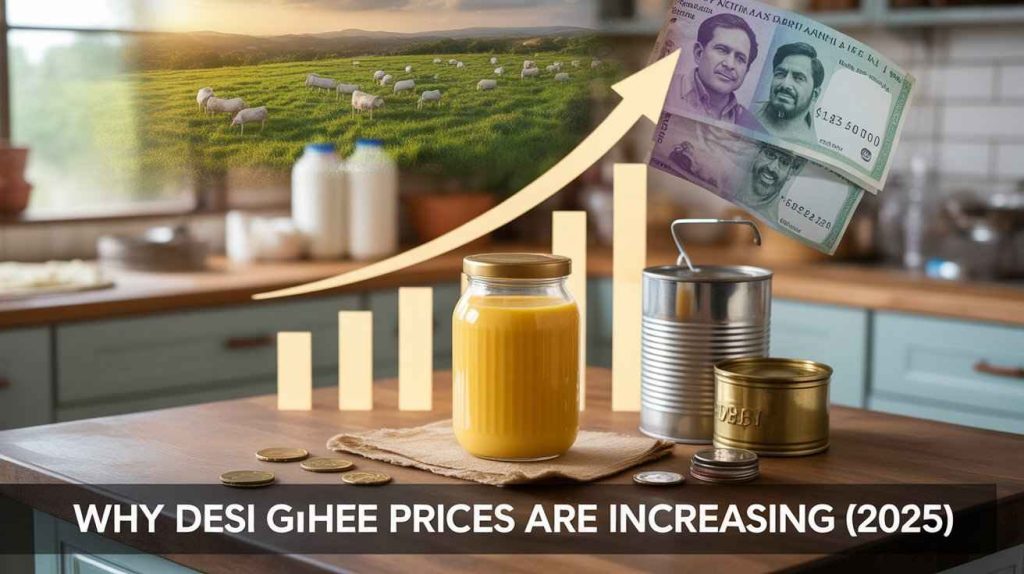
Why Desi Ghee Prices Are Increasing, once an affordable kitchen essential in every Pakistani household, is now becoming a luxury for many families. Over the last few years, prices have climbed significantly, raising concern among both consumers and producers.
In 2025, the average price of pure desi ghee in Pakistan ranges between Rs. 3,200 and Rs. 4,500 per kilogram, depending on quality and brand. Why Desi Ghee Prices Are Increasing But what’s behind this consistent rise? Let’s break down the main reasons driving desi ghee price increases, and how these market changes are shaping the future of this golden ingredient.
📊 Rising Milk Prices — The Core Driver
The foundation of desi ghee is pure cow or buffalo milk, and its cost directly affects ghee production. Over the last few years, Pakistan’s raw milk prices have increased by 25–30%, mainly due to:
- Higher feed costs for dairy animals
- Shortage of green fodder due to climate changes
- Rising fuel and transport costs
- Seasonal supply fluctuations
Since milk makes up more than 70% of ghee production cost, any rise in dairy prices immediately impacts retail ghee prices.
🏭 High Production & Processing Costs
Producing desi ghee involves several stages — boiling, clarifying, filtering, and packaging. In 2025, manufacturers are facing higher operational costs due to:
- Increased electricity and gas prices
- Expensive packaging materials (especially glass jars and tin containers)
- Labor cost inflation
- Modern equipment maintenance
Small-scale producers and dairy farms have particularly felt the pressure, passing these costs on to consumers to stay profitable.
🌾 Inflation & Currency Fluctuations
Pakistan’s general inflation has averaged around 22–25% in 2025, affecting almost every consumer product. When the Pakistani rupee weakens against the dollar, import-related expenses for packaging, machinery, and transport fuel increase — adding further pressure to ghee pricing.
Additionally, global oil prices indirectly impact local logistics and feed transportation, raising the cost of milk and related products.
🧪 Shift Toward Organic and Branded Ghee
Consumers are increasingly shifting from unbranded, loose ghee to certified and branded options that guarantee purity. While this is great for quality control, branded ghee often comes with:
- Better packaging and labeling
- Marketing and distribution costs
- Quality testing and certification expenses
As a result, brands like Olper’s, Nurpur, and Adam’s price their ghee higher than local alternatives, reflecting added assurance of purity and consistency.
Low Milk Yield & Dairy Supply Chain Issues
Pakistan’s dairy sector faces recurring supply challenges. Cow and buffalo milk yields are dropping due to poor animal nutrition and outdated farming methods.
Additionally, many small dairy farmers lack access to cold storage and reliable transport systems, leading to milk spoilage and wastage — reducing available supply and pushing ghee prices up.
🌦️ Climate Change Impact on Feed and Fodder
UnpredictableWhy Desi Ghee Prices Are Increasing rainfall patterns, droughts, and rising temperatures have disrupted fodder cultivation in key agricultural zones.Why Desi Ghee Prices Are Increasing Limited feed availability increases the cost of animal nutrition, which directly raises the price of milk and dairy fats — the key ingredients for desi ghee.
🧾 Increased Demand During Festive and Wedding Seasons

Desi ghee is deeply tied to Pakistani food culture. Demand spikes during Ramadan, Eid, and the winter season — especially for traditional sweets and festive cooking.
This seasonal surge leads to temporary supply shortages, allowing sellers to raise prices in response to increased demand.
💡 Growing Export Demand
Pakistan’s desi ghee is gaining popularity in Middle Eastern and South Asian markets, especially among expatriate communities. Exports to the UAE, Saudi Arabia, and Qatar have increased, diverting part of the domestic supply toward foreign buyers — creating a supply-demand gap that results in local price hikes.
📦 Packaging & Transportation Costs
The cost of tin, glass, and eco-friendly packaging materials has surged globally. Since premium brands prioritize airtight packaging to retain freshness, this directly adds to the final price.
Additionally, fuel price hikes increase distribution and delivery costs, especially for products shipped across provinces or sold via online platforms.
🏠 Rise in Consumer Awareness and Quality Expectations
Consumers today demand pure, chemical-free, and certified desi ghee. To meet these expectations, producers are investing more in:
- Quality testing labs
- Hygienic processing units
- Transparent labeling systems
These additional steps ensure better quality but increase manufacturing costs — reflected in the retail price.
📉 Unregulated Local Market Competition
Unbranded or fake ghee sold in local markets sometimes contains vegetable oils and artificial flavors, creating unfair price competition.
To stay competitive, genuine producers often need to maintain affordable pricing while facing higher production costs — leading to reduced profit margins and occasional price adjustments.
🌍 Global Market Influence

Pakistan isn’t isolated from global dairy trends. International fluctuations in butter and milk fat prices affect domestic ghee rates. Why Desi Ghee Prices Are Increasing As major exporters like India and New Zealand adjust prices, Pakistan’s market adapts accordingly to remain competitive.
🔮 Future Outlook: Will Desi Ghee Prices Keep Rising?
Experts predict that Why Desi Ghee Prices Are Increasing prices may continue to rise moderately over the next few years if production challenges persist. However,Why Desi Ghee Prices Are Increasing improved dairy management, stable inflation, and government support for the dairy industry could help control future increases.
Technological innovations — such as modern dairy farming and better cold-chain logistics — may also help stabilize supply and lower costs in the long run.
🧠 Tips for Consumers
- Buy ghee in bulk during off-season for lower prices.
- Choose locally sourced cow ghee for better value.
- Verify purity through labeling and certification.
- Support ethical brands that promote sustainable dairy farming.
🌟 Conclusion
The rising price of desi ghee in 2025 reflects a complex mix of economic,Why Desi Ghee Prices Are Increasing environmental, and consumer-driven factors. From milk shortages and inflation to packaging and export trends, every stage of the supply chain influences cost.
While Why Desi Ghee Prices Are Increasing are unlikely to drop drastically soon, increasing awareness about purity and nutrition means consumers are willing to pay more for genuine quality. Why Desi Ghee Prices Are Increasing ghee remains not just a food product — but a symbol of Pakistan’s traditional taste and wellness heritage.
FAQs on Why Desi Ghee Prices Are Increasing
1. Why are desi ghee prices increasing in 2025?
Why Desi Ghee Prices Are Increasing Due to higher milk costs, inflation, and increased production expenses, prices have risen steadily this year.
2. Does milk shortage affect ghee prices?
Yes, milk shortages directly limit supply, raising the cost of pure cow and buffalo-based ghee.
3. Are branded ghee products more expensive?
Branded ghees are pricier because of quality testing, packaging, and certification costs.
4. Will desi ghee prices decrease soon?
Not likely — unless milk prices and inflation stabilize, rates will stay moderately high.
5. How does climate change impact ghee prices?
Unpredictable weather reduces fodder availability, raising animal feed costs and milk prices.
6. Is organic desi ghee costlier than regular ghee?
Yes, organic ghee requires pure milk and chemical-free processing, making it more expensive.
7. What can consumers do to save money?
Buy ghee in bulk during off-seasons or switch to locally produced cow ghee for better value.
